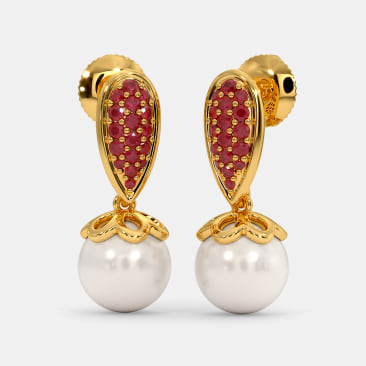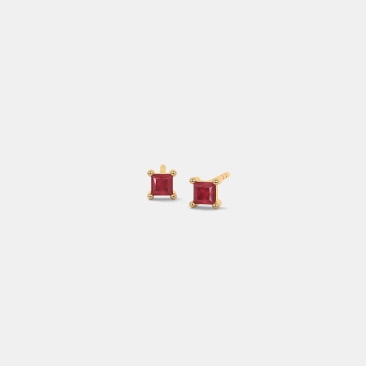Ruby
For every jewellery lover, R is for Rubies, and why not! They are one of the most valued and sought-after gemstones in the world of jewellery. In Sanskrit, it is known as the Ratnaraj or the King of Gems – a fitting name for a gem that rules the world of gemstones with its lustre, colour, and allure. What’s more? These red stones look exceptionally charming whether they are set in gold, white gold or rose gold. Are you looking to buy ruby jewellery? Here is a comprehensive guide to help you make an informed decision.
Overview
Rubies need no introduction, yet here are some quick facts about the king of gems. They are a part of the corundum family of gemstones. They have a hardness factor of 9 on the Moh’s Scale. This means, rubies are one of the hardest gems after diamonds. The presence of trace elements like chromium gives these stones their colour which can range from light red to deep purplish red. The more the presence of chromium in a ruby, the deeper its colour will be. Due to the red colour, people often consider this stone as symbolic of love and passion. Many of the world’s most famous rubies have been found in Myanmar. Weighing 18,696 carats, the 125 West Ruby is the largest uncut ruby in the world.
History of Rubies
This stone derives its name from the Latin word ‘ruber’ meaning red. The earliest mentions of a ruby are in the Holy Bible and in ancient Sanskrit texts. Rubies are also included in Pliny’s ‘Natural History’ text written in 1 AD. Over the centuries, they have been linked with a host of legends. In Myanmar, soldiers believed inserting a ruby into their skin made them invincible. In India, donating a ruby is a way to honor Lord Krishna. It is also believed that the person will be born as an emperor in his next life. These red stones were highly prized in other parts of Asia too. History has it that as early as 200 B.C, they were traded along China’s North Silk Road.
Types of Rubies: Natural vs. Synthetic
Naturally found rubies are among the most expensive gemstones in the world. As they became more popular and the demand increased, scientists began looking for ways to create them. Jewelers sell these rubies as created, synthetic or cultured varieties. Such stones are usually much cheaper compared to natural ones. Synthetic stones appear identical to their natural counterparts. They also have the same chemical composition and physical properties. They often appear brighter than natural rubies. Only a gemologist with a powerful microscope can tell natural and synthetic stones apart.
Birthstones and Anniversary Stones
Rubies are the birthstone for those born in July. The stone is associated with Sun and hence is ideal for people with Leo sign. They are also connected to a couple’s fifteenth and fortieth wedding anniversary.
Real Rubies vs. Fake Rubies
Real and naturally occurring rubies are rare and expensive. Hence, it is important to be able to tell the difference between real and fake variants of the stone. Tourmalines, garnets, and coloured glass are often used as imitation rubies. These materials are softer than the real ones. Thus, if a ruby were to rub against them, it would scratch them easily. Real rubies are also denser and heavier as compared to fake ones.
Do you own one of these red beauties and want to know whether it is real or not? To test the stone, you could scratch it against another surface. If it leaves a red mark on the surface, the stone has been coloured and is not a real ruby. A 10 power microscope can also be used to test the authenticity of the stone. This gives a clearer image of the details of your rubies. Real rubies will have sharp edges, facets, and clean cuts. On the other hand, if the stone appears to have rounded edges, it is probably a fake.
How to Buy Ruby Jewellery?
This gemstone is amongst the most expensive ones available in the market today. Hence, you must be very careful when buying ruby ornaments such as ruby rings, bangles, mangalsutras, or necklaces. There are a few things you should consider when you buy ruby jewellery from offline or online stores, namely its cut, clarity, colour, and carat weight.
Cut: The way a ruby is cut makes a big difference to its luster and sparkle. It also impacts the stone’s ability to showcase different colours in different directions. This is known as pleochroism. These stones are typically found in flat tabular shapes, and hence they are usually cut into oval and cushion shapes. Step-cut pavilions with concentric square or rectangle shaped facets are also commonly used in making ruby jewellery. They may also be shaped using round, emerald, triangular, pear and marquise cuts.
Clarity: It is extremely difficult to find an inclusion-free natural ruby. In fact, all naturally occurring rubies contain imperfections. Valuation of a ruby depends heavily on how visible the inclusions are. Obvious inclusions make a ruby appear dull or transparent, reducing its value. Thin mineral inclusions called needles are commonly seen in rubies. They may appear long or short, distinct or in groups. Inclusions that scatter light can improve the appearance of a ruby and make it brighter. Needles that cross each other can also create a star effect, which increases the value of the stone.
Colour: Even a slight difference in colour can greatly impact the price of this gemstone. A ruby’s colour is the most important aspect of its valuation. The highest quality stones have a bright red to a deep purplish red. However, it should not be too dark as it could make the stone appear less bright. The line between a light orangish-red ruby and a pink sapphire is blurred.
Carat: Rubies can be sorted as commercial quality and fine quality rubies. The latter is rarely found weighing more than 1 carat. However, commercial quality variants can be found in many sizes. Thus, a 5 carat fine quality ruby costs much more as compared to a 5 carat commercial quality ruby.
How to Look After Your Ruby Jewellery?
Rubies are hard gemstones and hence they are highly resistant to scratches and fractures. However, they may lose their lustre and sheen if not cleaned and stored properly. Here are a few things you should consider if your own a piece of ruby jewellery:
- Being one of the hardest gemstones, rubies can cause damage to other softer gemstones. Hence, do not store your ruby jewellery with any other jewellery. Ideally, you should have a fabric-lined box with individual slots for your ruby jewellery. Else, you could wrap each piece in soft tissue paper.
- Oils and dirt can attach themselves to these gemstones, making them look dull. It is important that you clean your rubies regularly. To do this, you should soak the jewellery in a solution made of gentle detergent and warm water. You may then use a soft-bristled toothbrush to further clean them. This removes the built-up dirt in the intricate parts of your jewellery.
- Though rubies are hard, you should never exert heavy pressure on them. You should also avoid wearing them while cleaning, gardening, etc.
The colour and allure of the stone make it an ideal choice for expressing powerful emotions. Whether you are buying a pair of ruby-studded white gold earrings or a gold necklace studded with rubies and diamonds, it sure is a worthy addition to your jewellery collection. That’s not all. Do you know that due to its hardness, this stone is often used to make medical instruments and lasers? Remarkable, isn’t it?




